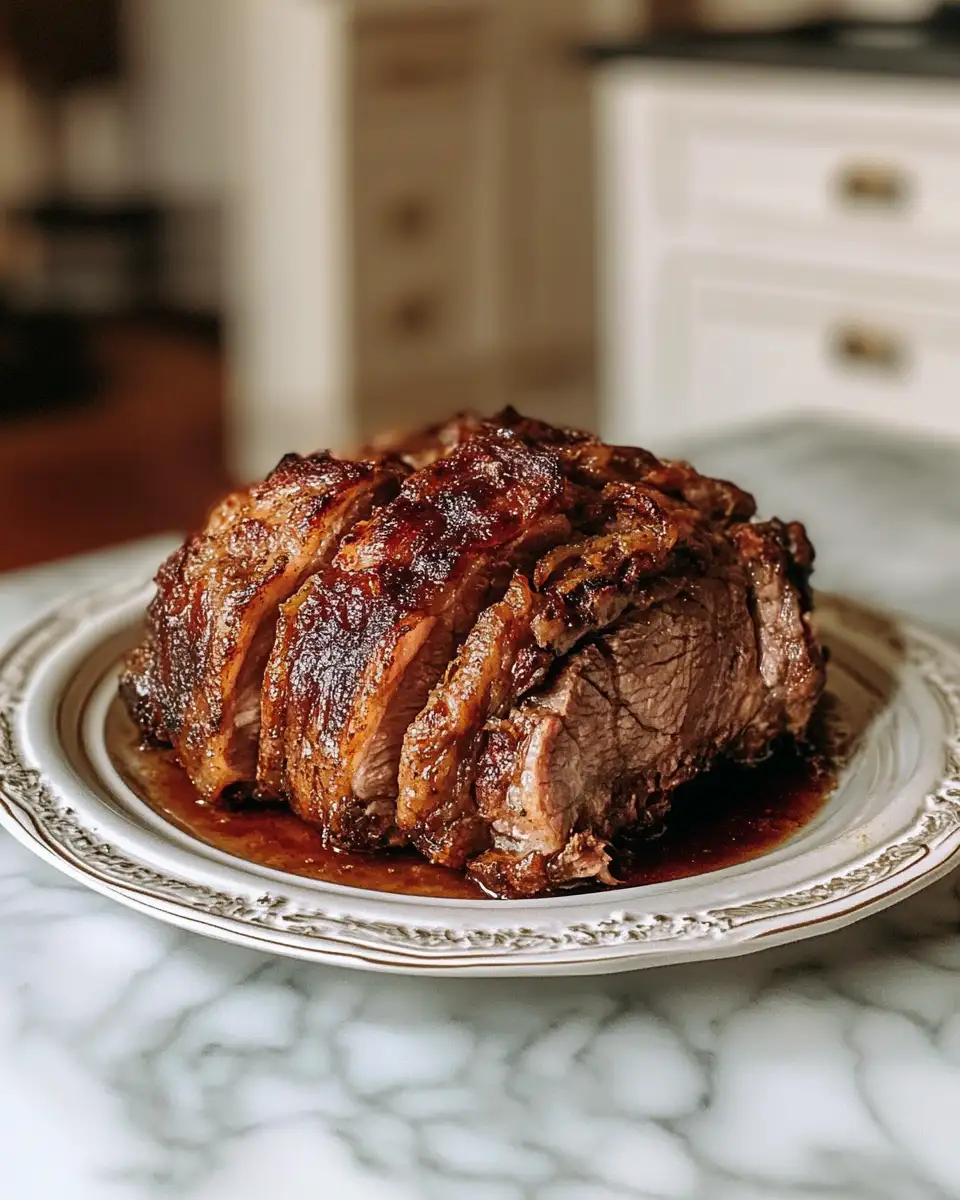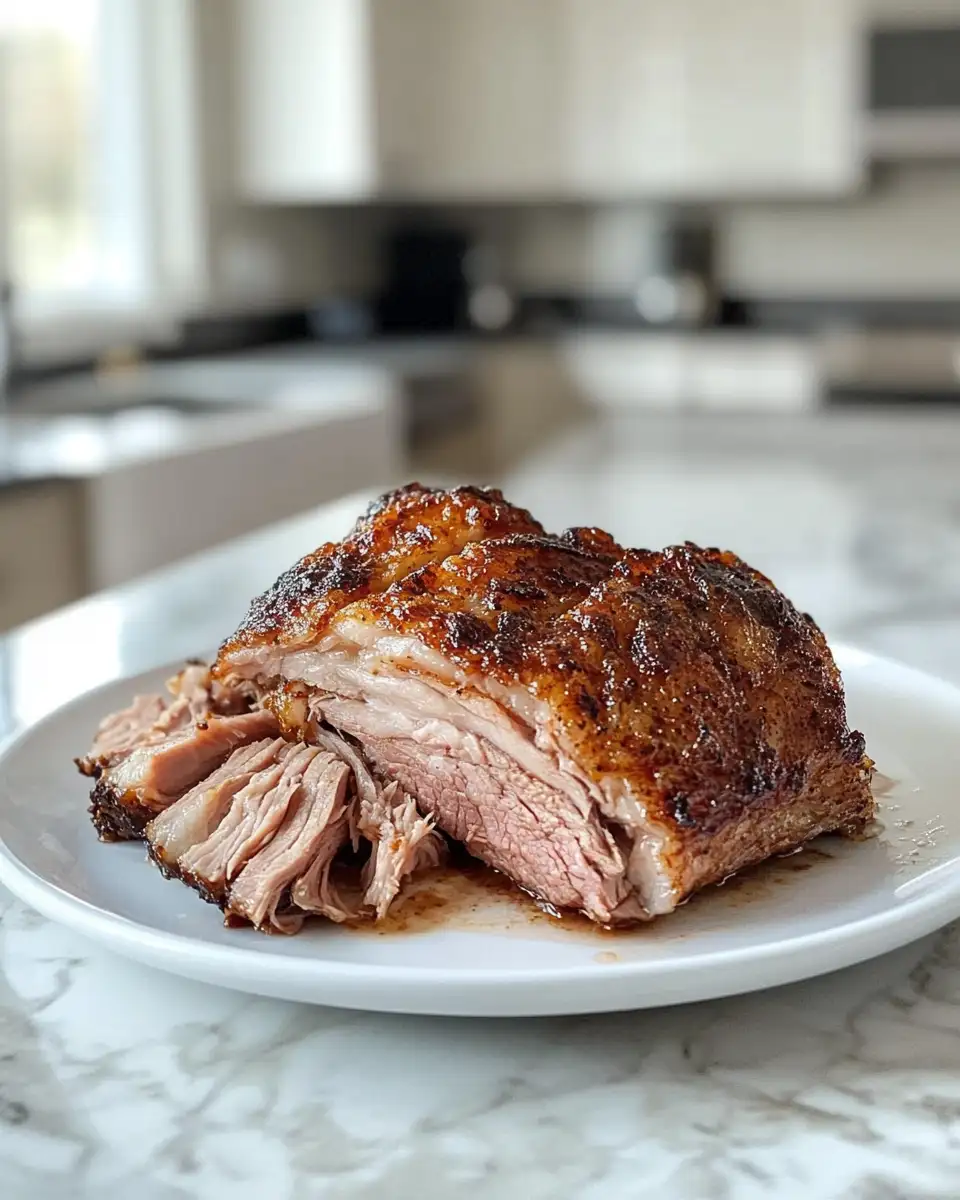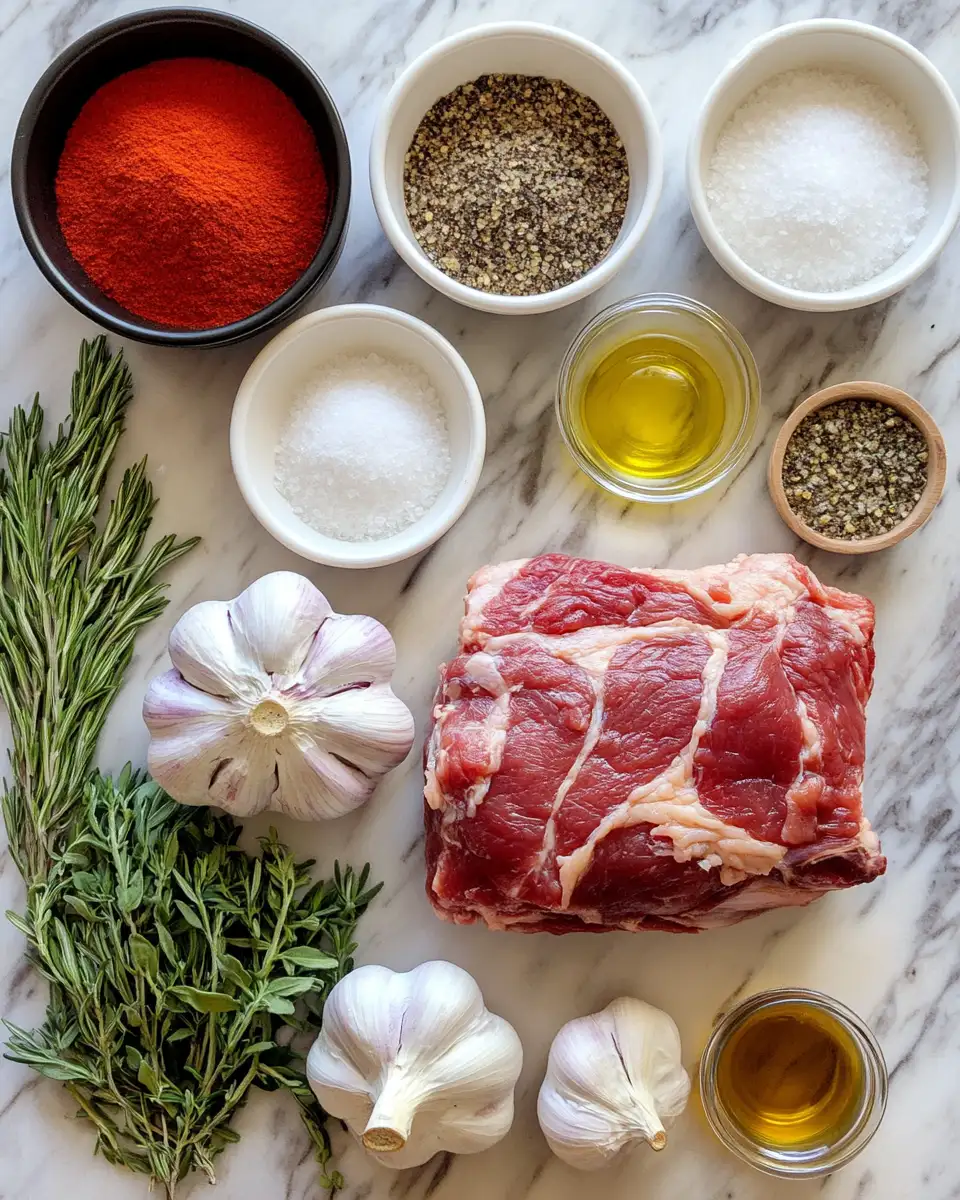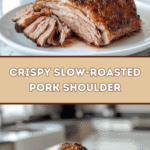There’s something truly magical about a Crispy Slow-Roasted Pork Shoulder that just draws people together around the table. I still remember the first time I made this dish back when my kitchen experiments were less about precision and more about sheer curiosity. The crackling skin, the tender, juicy meat that practically melts in your mouth—it’s comfort food at its finest, but with a little flair. Living in sunny San Diego, I love how this recipe brings a bit of warm, rustic charm into my busy family dinners, especially when my little ones are happily dipping their pork bites into ketchup. This slow-roasted beauty is as much about patience as it is about flavor, and I’m excited to share why it’s become a staple in my home.
Table of Contents
Why You’ll Love This Crispy Slow-Roasted Pork Shoulder
This recipe stands out because it perfectly balances two seemingly opposite textures: irresistibly crispy crackling and tender, juicy meat beneath. From my early days in restaurant kitchens, I learned the importance of timing and temperature, which are key to this dish’s success. It’s also incredibly forgiving—a perfect project for weekend cooking when you can let the oven do the work while you relax or play with the kids. Plus, it’s a crowd-pleaser; I’ve hosted more than one family gathering where this pork shoulder disappeared faster than I expected, sparking plenty of warm laughter and second helpings.
Ingredients You’ll Need for This Crispy Slow-Roasted Pork Shoulder
The key to this dish lies in selecting the right ingredients, especially the pork shoulder itself. I always opt for a piece with a good layer of fat and skin—this is crucial for achieving that perfect crackling. Growing up in southern England, my mum always reminded me that quality ingredients make even the simplest recipes shine, and I’ve carried that philosophy across the Atlantic. Fresh herbs and sea salt are non-negotiable for me, adding depth without overwhelming the natural flavor.
- 4 to 5 pounds bone-in pork shoulder with skin on
- 1 tablespoon sea salt (plus extra for the skin)
- 2 teaspoons black pepper
- 2 teaspoons smoked paprika
- 4 garlic cloves, minced
- 1 tablespoon fresh rosemary, finely chopped
- 1 tablespoon olive oil
- 1 cup chicken stock or water (for roasting pan)
If you don’t have smoked paprika, a pinch of cayenne or regular paprika works well, too. For a slightly different aroma, thyme can replace rosemary. And if pork shoulder isn’t available, a pork butt cut can be a good substitute, though the cooking time may vary.
Nutrition Facts
- Calories: Approximately 480 per serving (6 oz)
- Protein: 38g
- Fat: 32g (mostly from the pork fat and crackling)
- Carbohydrates: 1g
- Fiber: 0g
- Sugar: 0g
- Sodium: 750mg (variable depending on salt used)
While this dish is rich, it’s also packed with protein and free from added sugars or carbs, making it a hearty centerpiece for a balanced meal.
Print
The Ultimate Guide to Crispy Slow-Roasted Pork Shoulder That Melts in Your Mouth
Learn how to make delicious Crispy Slow-Roasted Pork Shoulder. Easy recipe with step-by-step instructions.
- Total Time: 45 minutes
- Yield: 4 servings 1x
Ingredients
The key to this dish lies in selecting the right ingredients, especially the pork shoulder itself. I always opt for a piece with a good layer of fat and skin—this is crucial for achieving that perfect crackling. Growing up in southern England, my mum always reminded me that quality ingredients make even the simplest recipes shine, and I’ve carried that philosophy across the Atlantic. Fresh herbs and sea salt are non-negotiable for me, adding depth without overwhelming the natural flavor.
- 4 to 5 pounds bone-in pork shoulder with skin on
- 1 tablespoon sea salt (plus extra for the skin)
- 2 teaspoons black pepper
- 2 teaspoons smoked paprika
- 4 garlic cloves, minced
- 1 tablespoon fresh rosemary, finely chopped
- 1 tablespoon olive oil
- 1 cup chicken stock or water (for roasting pan)
If you don’t have smoked paprika, a pinch of cayenne or regular paprika works well, too. For a slightly different aroma, thyme can replace rosemary. And if pork shoulder isn’t available, a pork butt cut can be a good substitute, though the cooking time may vary.
Instructions
- Start by drying the pork skin thoroughly with paper towels—this step is essential for crisping the crackling.
- Score the skin carefully using a sharp knife, making shallow cuts about 1/4 inch apart, being careful not to cut into the meat.
- Rub the entire pork shoulder with olive oil, then mix salt, pepper, smoked paprika, minced garlic, and rosemary. Massage this mixture into the meat and skin, making sure the seasoning gets into the scores.
- Place the pork shoulder on a rack in a roasting pan, skin side up. Pour the chicken stock or water into the base of the pan to keep the meat moist during cooking.
- Roast in a preheated oven at 275°F (135°C) for about 4 hours. This low and slow method breaks down the connective tissue, ensuring tender meat.
- Increase the oven temperature to 450°F (230°C) for the last 20-30 minutes to crisp up the skin. Keep a close eye on it to avoid burning.
- Remove the pork from the oven and let it rest for at least 15 minutes before carving. This helps the juices redistribute, keeping the meat moist.
In my experience, patience really pays off here. I once rushed the crackling step, and while the meat was lovely, the skin was less than crackling-worthy—lesson learned!
- Prep Time: 15 minutes
- Cook Time: 30 minutes
- Category: Main Dish
- Method: Cooking
- Cuisine: International
Steps to Create Your Crispy Slow-Roasted Pork Shoulder
- Start by drying the pork skin thoroughly with paper towels—this step is essential for crisping the crackling.
- Score the skin carefully using a sharp knife, making shallow cuts about 1/4 inch apart, being careful not to cut into the meat.
- Rub the entire pork shoulder with olive oil, then mix salt, pepper, smoked paprika, minced garlic, and rosemary. Massage this mixture into the meat and skin, making sure the seasoning gets into the scores.
- Place the pork shoulder on a rack in a roasting pan, skin side up. Pour the chicken stock or water into the base of the pan to keep the meat moist during cooking.
- Roast in a preheated oven at 275°F (135°C) for about 4 hours. This low and slow method breaks down the connective tissue, ensuring tender meat.
- Increase the oven temperature to 450°F (230°C) for the last 20-30 minutes to crisp up the skin. Keep a close eye on it to avoid burning.
- Remove the pork from the oven and let it rest for at least 15 minutes before carving. This helps the juices redistribute, keeping the meat moist.
In my experience, patience really pays off here. I once rushed the crackling step, and while the meat was lovely, the skin was less than crackling-worthy—lesson learned!
Tips for Making the Best Crispy Slow-Roasted Pork Shoulder
Getting this dish perfect requires attention to a few key details, many of which I’ve learned firsthand from both my family’s kitchens and professional experience.
- Pat the skin bone dry the day before and leave it uncovered in the fridge overnight to dry out the skin.
- Score the skin just right—too shallow and it won’t crisp, too deep and you lose the juicy meat.
- Don’t skip the high heat blast at the end; it’s essential for that crackling crunch.
- Keep the roasting pan’s liquid topped up, but don’t let the pork sit in it—elevate it on a rack.
- Rest the meat after cooking; rushing this step squeezes out precious juices.
These little techniques separate a good roast from a great one. My early kitchen days taught me that mastering timing and textures is key—this recipe embodies that lesson beautifully. Learn more: related recipe
Serving Suggestions and Pairings

This dish is incredibly versatile and works beautifully for various occasions—from casual family dinners to festive celebrations. I often serve it with simple sides that complement the rich pork without overpowering it.
- Classic roasted root vegetables like carrots and parsnips
- Buttery mashed potatoes or creamy polenta
- Crisp apple slaw or tangy pickled cucumbers to cut through the richness
- A glass of medium-bodied red wine, such as a Pinot Noir or Zinfandel
- Fresh crusty bread to soak up the pan juices
I find this roast pairs wonderfully with seasonal sides. In the cooler months, it’s perfect with hearty root vegetables, while in warmer weather, a fresh salad brightens the plate. My kids adore it simply sliced with their favourite ketchup dip, which always makes me smile.
Storage and Reheating Tips
Proper storage ensures you can enjoy leftovers just as much as the fresh dish. I often make this roast ahead for busy weeknights or to stretch it across a couple of meals.
- Store leftover pork in an airtight container in the refrigerator for up to 3 days.
- To keep the meat moist when reheating, add a splash of broth or water and cover with foil.
- Reheat gently in a low oven (around 300°F/150°C) to avoid drying out the pork.
- If you want to refresh the crackling, place the skin under a hot broiler for a few minutes—but watch closely to avoid burning.
From my experience, slow reheating is the best way to maintain tenderness, especially with leaner cuts. It’s a great recipe for meal prep, saving time without sacrificing flavor.
Frequently Asked Questions
What are the main ingredients for Crispy Slow-Roasted Pork Shoulder?
The main ingredients for Crispy Slow-Roasted Pork Shoulder include the items listed in our ingredients section above. Each ingredient plays a crucial role in achieving the perfect flavor and texture.
How long does it take to make Crispy Slow-Roasted Pork Shoulder?
The total time to make Crispy Slow-Roasted Pork Shoulder includes both preparation and cooking time. Check the recipe card above for exact timing details.
Can I make Crispy Slow-Roasted Pork Shoulder ahead of time?
Yes, Crispy Slow-Roasted Pork Shoulder can often be prepared in advance. Store it properly in an airtight container in the refrigerator and consume within the recommended timeframe.
What can I serve with Crispy Slow-Roasted Pork Shoulder?
Crispy Slow-Roasted Pork Shoulder pairs well with various sides and accompaniments. Consider the serving suggestions mentioned in the recipe for the best dining experience.
Is Crispy Slow-Roasted Pork Shoulder suitable for special diets?
Depending on the ingredients used, Crispy Slow-Roasted Pork Shoulder may be adapted for various dietary needs. Check the ingredients list and consider substitutions as needed for your dietary requirements.
Final Thoughts
This Crispy Slow-Roasted Pork Shoulder is one of those recipes that feels like a warm hug on a plate. It’s approachable, satisfying, and perfect for bringing people together. I’d love to hear how it turns out for you—don’t hesitate to share your kitchen stories or questions. After all, cooking is a journey best shared at the table.
















